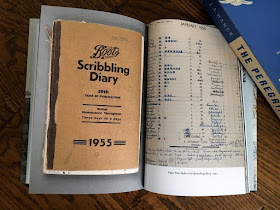Rachel Whiteread, Chicken Shed, 2017
This post can be read as a sequel to one I wrote nine years ago on Rachel Whiteread's move to making art for the landscape. In 'Ebbsfleet Landmark' I described her proposal for a monumental sculpture, which would have taken the form of the cast of a house on a mountain of recycled rubble (the winning proposal by Mark Wallinger was never built). In a postscript I referred to one of her 'Shy Sculptures', casts of sheds and similar structures, the latest of which has been installed in front of Tate Britain as part of their excellent retrospective exhibition. Last week I went to a talk at the gallery which covered her entire career but touched briefly on these recent works. She told us that she sees the 'Shy Sculptures' now as an ongoing lifelong project, already encompassing works in Norway, Norfolk and the California desert. She made a direct comparison with Robert Smithson's Spiral Jetty and Walter De Maria's Lightning Field, saying she'd like it if people tried to seek them out, travelling to remote locations like those cultural tourists who head for the American West to experience first-hand the foundational works of land art.
Rachel Whiteread, Shack, 2016
Tate wall display - photography permitted
Whiteread has described sheds as beautiful things with their own poetry, “they are furniture for people to dream away their lives in.” Sheds and cabins have fascinated contemporary artists, from Cornelia Parker to Tracey Emin, and they have a long cultural history. I have often referred here to similar modest structures out in the landscape - studios, retreats, hermitages. The 'Shy Sculptures' Whiteread made in California preserve the negative space of two 1950s cabins that were abandoned in the desert. They took five years to make and were commissioned by Jerry Sohn, who is creating a collection of site-specific art that also includes works by Lawrence Weiner and Richard Long. Whiteread described them in her talk as 'shotgun shacks' which (at least to a British listener, less used to the term) instantly brought to mind Talking Heads' song Once in a Lifetime. David Byrne's lyrics, like Rachel Whiteread's sculptures, refer to transience and timelessness.
In interviews Whiteread has said she dislikes 'plop art', 'making things and just putting them in places for the sake of it.' Her 'Shy Sculptures' have to be in the right locations. It would be interesting to know more about how she thinks they affect the surrounding landscape. Presumably they will be left to slowly weather into their locations, unlike House, which was bulldozed in 1994. At the Tate, Whiteread talked again about the huge controversy surrounding House, as well as her bureaucratic struggles over the Vienna holocaust memorial (she is returning to the city this month for the first time since it was finally installed). I now live in a property rather like House and wish it was still there to visit. It prompted the best thing I've read by Iain Sinclair, his essay 'The House in the Park: A Psychogeographical Response'. The villain of this piece, Lib Dem councillor Eric Flounders, reemerged briefly from obscurity ten years later in a Guardian story about the launch party for Cunard's QM2 (where Jimmy Savile 'was sporting an NHS swipe card in the name of Al Pacino alongside his gongs.'). I doubt that Flounders has any regrets. Rachel Whiteread said she might consider doing another whole-house cast, but it would be pointless to try to recreate House. Once in a lifetime...








_-_Claude_Monet.jpg)
